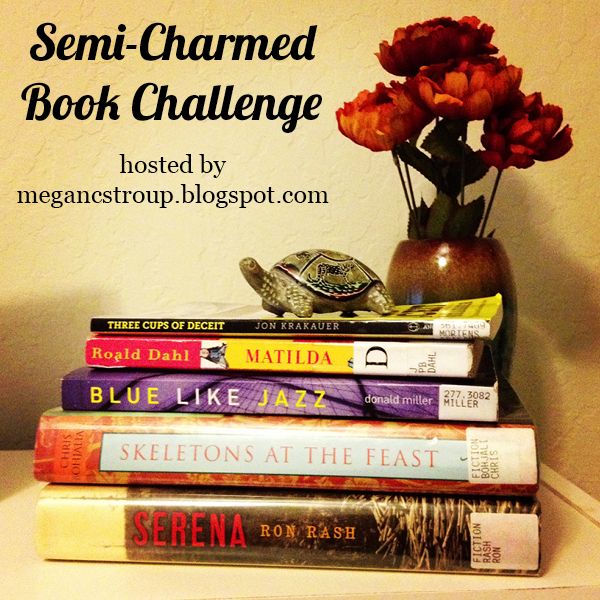I am signing up for the first autumn installment of the Semi-Charmed Book Challenge!
Here are the details
- The challenge will run from October 1, 2013, to December 31, 2013. No books that are started before 12 a.m. on October 1 or finished after 11:59 p.m. on December 31 will count.
- New rule: In the past, I haven't allowed rereads because I said I wanted you to experience new books with my challenges. Now, however, I've decided up to three books for the challenge can be rereads. This is to allow you to revisit books from your childhood or young adulthood that you might get more out of now, or to finish books you started a long time ago but never completed. Please reread the entire book within the timeframe of the challenge in order to count it; no simply finishing old books or partial rereads!
- Each book must be at least 200 pages long. Audiobooks are fine, as long as the print versions meet the page requirements.
- A book can only be used for one category. If you want to switch the category later, that's fine, just be sure to account for that in your point total.
- The highest possible total is 200 points, and the first five people who finish the challenge will win a featured/guest post on Semi-Charmed Kind of Life and be invited to contribute a category for the winter challenge. Good luck!
And now for the exciting part: The challenge categories! As of this posting, five people have completed the summer book challenge, and I invited each of them to contribute their own category to the autumn challenge. If you win the autumn challenge, you'll get to help me make the winter challenge! Fun, right?
5: Read a book that does not have "the," "a" or "an" in the title - Police by Jo Nesbo
10: Read a book that has been featured in Oprah's Book Club. This list includes all the books up until 2010. (Submitted by SCSBC13 winner Erin.)- Love in time of Cholera
10: Read a book that takes place in the state where you currently live. If you do not live in the U.S., read a book that takes place in the country where you live. (Submitted by SCSBC13 winner Megan.) Dead Man's Time by Peter James15: Read an epistolary novel, which is a book written in letters, emails, diary entries or other documents. See this Goodreads list if you need an idea, but make sure it's actually an epistolary novel first! Goodreads lists aren't verified, so non-epistolary books could have snuck their way on there- Diary of an Ordinary Woman 1914-1995 by Margaret Froster15: Read a book first published in 2013- W is for Wasted by Sue Grafton (8/10/13)15: Read a book with something spooky in the title. (Submitted by SCSBC13 winner Bev.) Jack O' Lantern20: Read a book with "air," "water," "earth" or "fire" in the title. (Submitted by SCSBC13 winnerGypsi.) Fireside Mystery Book by Frank Owen20: Read a book on which a television series has been based (e.g. Orange is the New Black, Gossip Girl, Pretty Little Liars, Friday Night Lights, etc.). Cross and Burn by Val McDermid25: Read a fiction book that has someone’s first and last name in the title (e.g. The Story of Edgar Sawtelle, The Adventures of Tom Sawyer, Bridget Jones's Diary, etc.). John Thorndyke's Cases by R Austin Freeman30: Read two books by the same author. They can be in the same series, but do not have to be. Co-authors do not count (i.e. the author must be the sole author of each book). A Man Lay Dead and A Vintage Mystery by Ngaio Marsh35: Read a fiction and nonfiction book about the same topic. (Example: Extremely Loud and Incredibly Close and The Woman Who Wasn't There are both about 9/11. I'm planning on doing a whole post with a list of ideas soon, if you care to submit any!) The Lodger by Marie Belloc Lowndes and Jack the Ripper and the East End Compiled and edited by Alex Werner
















